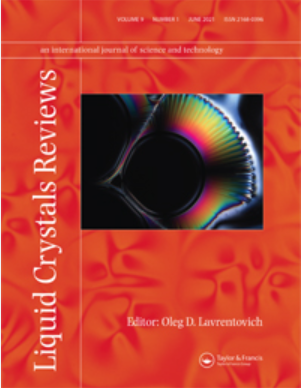Surface polymer-stabilized dual frequency chiral liquid crystals
IF 4.2
3区 材料科学
Q2 CHEMISTRY, PHYSICAL
引用次数: 1
Abstract
Polymer-liquid crystal (LC) composite materials provide cost-effective ways to achieve enhanced electro-optic functionalities. Corresponding bulk-dispersed and phase-separated (of various degrees) morphologies were intensively studied in the past and are shortly described in this work. In addition, we consider the specific case when the polymer-LC structures are formed near to the cell substrates. To achieve this, partially cured and oriented polymer coatings are used as alignment layers for dual frequency chiral LC. The partial curing is intended to allow a partial interpenetration between the LC and the polymer molecules to form surface-stabilized polymer networks. After a short interpenetration period (between the polymer coatings and the bulk LC), a positive dielectric torque is applied and UV exposition is used to definitely cure the material system. Our electro-optical, spectroscopic and microscopic studies show that the pre-curing duration plays a crucial role in the behavior of the cell. It is shown that the molecular interdiffusion generates defects of LC alignment around polymer aggregates on the cell's internal surfaces. The obtained out-of-plane alignment and small polymer aggregates are at the origin of formation of controllable light scattering. Among others, some linear defects are formed by the positive torque, which are, however, eliminated when a negative dielectric torque is applied.表面聚合物稳定的双频手性液晶
聚合物-液晶(LC)复合材料为实现增强的电光功能提供了经济有效的方法。相应的块体分散和相分离(不同程度)形态在过去被深入研究,并在本工作中简要描述。此外,我们还考虑了聚合物- lc结构在细胞底物附近形成的特殊情况。为了实现这一点,部分固化和定向聚合物涂层被用作双频手性LC的对准层。部分固化旨在允许LC和聚合物分子之间的部分互穿以形成表面稳定的聚合物网络。经过短暂的互穿期(在聚合物涂层和块状LC之间),施加正介电扭矩,并使用紫外线照射来明确固化材料体系。我们的电光、光谱学和显微研究表明,预固化时间对细胞的行为起着至关重要的作用。结果表明,分子间扩散会在细胞内表面聚合物聚集体周围产生LC排列缺陷。得到的面外取向和小聚合物聚集体是可控光散射形成的根源。其中,一些线性缺陷是由正转矩形成的,然而,当施加负介电转矩时,这些缺陷就被消除了。
本文章由计算机程序翻译,如有差异,请以英文原文为准。
求助全文
约1分钟内获得全文
求助全文
来源期刊

Liquid Crystals Reviews
CHEMISTRY, PHYSICALCRYSTALLOGRAPHY&n-CRYSTALLOGRAPHY
CiteScore
7.60
自引率
5.90%
发文量
8
期刊介绍:
Liquid Crystals Reviews publishes review articles on all aspects of liquid crystal fundamentals and applied science, including experimental and theoretical studies of physical and chemical properties, molecular design and synthesis and engineering of liquid crystal devices. The Journal fosters cross-disciplinary exchange of ideas, encouraging authors to present material at a level accessible to specialists from other fields of science and engineering. Liquid Crystals Reviews provides the scientific community, in both academia and industry, with a publication of standing, guaranteed by the Editors and by the International Editorial Board who are active scientists in the worldwide liquid crystal community.
 求助内容:
求助内容: 应助结果提醒方式:
应助结果提醒方式:


